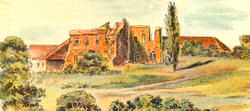History of Moravian Brethern at Reichenau
The following history is provided by SGGEE member Cy Harke and is reprinted with permission. Note that this district was not in Russian Poland. It was the region northeast of the city of Thorn (Torun).
GREATER REICHENAU DISTRICT
REICHENAU (Rychnowo)
The Settlers Commission in Pozan allowed Germans and Poles from Russian-Poland and Galicia to purchase land in this region. After negotiations between the Directors in Herrnhut and the Settlers Commission, certain places could be selected for Moravian settlers and the establishment of churches. By the end of 1905, over 100 families from Moravian congregations settled near Reichenau, 20 km east of Thorn. A congregation was formed in 1905 and an old granary was used for services. The old manor house became the parsonage. The Settlers Commission donated both buildings to the congregation. A large typical Moravian church was erected in 1913.
After WW I, many had to leave their farmsteads or sell at bargain prices. Due to a shortage of Pastors, the congregation received some assistance from Lodz, Leonberg or Stanislawow.
When work ended in 1945, the spire and bell of the Richenau church were taken down and placed beside the Catholic Chapel. The interior was converted to a school.
The following Pastors served Richenau and District:
1905 - 1913 Pastor Oskar Fabricius(1869-1951)
1913 - 1923 Pastor Hermann Hochstein(1876- )
Pastor Haglund - replacement during WW I
1923 - 1924 Pastor Ch. Wiemer(1866-1927)
1925 - 1929 Pastor Edmund Dahl(1867-1930)
1932 - 1934 Pastor Hans Preiswerk
1933 Pastor Hugo Kautz, assistant
1934 - 1935 Pastor Emanuel Schiewe(1900-1964)
1936 Pastor Hermann Stieb, assistant(1907- )
1938 Pastor J. Schick, assistant
1939 Pastor Heinrich Jabs, Youth Evangelist
Lay-workers: Dohring, Machel, Sauder, Skalee, Mittmann
Choir and band Directors: Ludwig Schulz, Gustav Bujak, Karl Prellwitz
HEINRICHSBERG, KNAPPSTADT
Church halls were built in these villages. Service was provided by Pastors from Reichenau.
DREILINDEN, KLODTKEN, TREUHAUSEN, FURSTENAU, SIEBSAU, ALTHAUSEN, BILAU, HOHENFELDE, KIELPIN, KRUSCHDORT, RADMANNSDORF, WITTENBERG, THORN, BROMBERG
There were no church halls at these locations. Moravian assemblies were visited by Pastors from Reichenau.
SCHLABAU
Settled in 1906, Schlabau was designated as a Moravian Colony by the Settlers Commission. They got ownership to an old manor estate which had a school, residence for teacher and a prayer hall. The prayer hall was to be shared with the Lutherans. The Commission called a Moravian teacher, Gunther, to take charge of the school. Directors at Herrnhut purchased a manor house at Wilhelmsee for use as a parsonage. Pastor Steinberg lived in the manor house for a time during his retirement.
Pastors from Leonberg and Lodz visited the Schlabau assembly for services.


